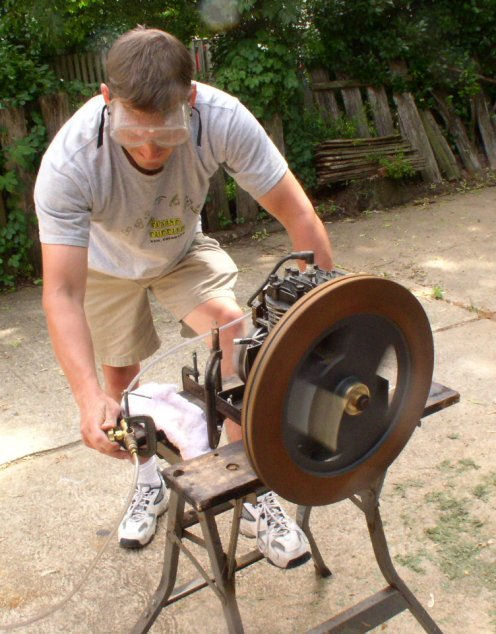Dennis |
I've known Dennis since he was 13, back when it wasn't so weird for a young boy to hang out with a 40-year-old guy. He's now about 40, married, got a young son and an engineering job that I like to think came about because of his association with me.Back around 1983, my next-door neighbor, a guy named Read, sent him to see me about his idea for putting a large spring coil on the rear wheel of his bicycle to make it accelerate rapidly from around 10 miles an hour to at least 30. He wanted speed, to could impress his friends, I think it was. But instead of a spring, we mounted a big water rocket on the bike, water pressurized with ~2,000 psi if nitrogen. It's impressive even if it didn't work that well -- and we learned a lot from the effort. We worked on science projects of various kinds over the years. We won an award from the county we live in for our studies of hydrogen/oxygen engines and extreme compact boilers. |
 Here's Dennis with a test engine in a project involving slowing operation (hence the large flywheel) and high efficiency. We needed to make a special cam and a high-temperature piston, but we didn't have to money to get anywhere, so we moved on the LED light art: |
One of our LED "Light Sculptures" |
We sold several pieces of work through our Comfortlight sight, which
has been dormant for a while. Dennis got a commission for the
LED unit above. I don't recall that it had a name, but he got a
nice
chunk of money for it -- and a lot of hassle, too, because he was
dealing with an actual customer. We learned from that unit, the
one above, that perception of colors depends on adjacent colors.
To wit: we used only Red, Green, and Blue LEDs, but in this
arrangement, if you look carefully, you will see such
"subtractive" type colors as browns, pastels and shades of khaki.
Edwin Land, the inventor of the Land camera and of the
Retinex Theory of color perception was, as far as we could tell,
correct: perception of color depends on the adjacent colors.
The customer is happy, we hope.
|